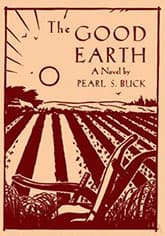The Good Earth
Critique • Quotes • At the movies
 First edition
First editionFirst publication
1931, United States
Literature form
Novel
Genres
Literary, historical fiction
Writing language
English
Author's country
United States
Length
Approx. 137,000 words

Louise Rainer and Paul Muni shine in The Good Earth, despite unconvincing Chinese makeup.
Greatness survives sentimental assault
The Good Earth (1937): Film, 138 minutes; director Sidney Franklin; writer Talbot Jennings, Tess Slesinger, Claudine West; featuring Paul Muni, Louise Rainer, Walter Connolly, Charlie Grapevin, Keye Luke
The Good Earth was a greater movie of a great novel in 1937 than it is now.
The novel is still great and the movie is still very good, with a powerful presentation of pre-revolutionary Chinese life in the provinces, focusing on one peasant family. Their life consists of daily struggles to survive—contending with the elements, locusts, overlords, marauders and each other. The main figure, Wang Lung, is a craftier and luckier farmer than most others, rising from desperate poverty to become an important landlord himself. His greatest luck is in being given, for a wife, the former slave O-Lan, who not only devotes herself to raising a family for him but at key moments takes selfless actions to save him and his growing wealth. He repays her in middle age by taking a younger second-wife.
This more or less follows the novel, with Hollywood's usual amount of simplifying and sentimentalizing.
But today when we view The Good Earth, we cannot help but be somewhat bewildered by the non-Asian appearance of the leads. Paul Muni and Louise Rainer are fine film actors of the period, but they don't look Chinese. They look like what they are, Europeans with pigtails and skin pulled tight to give them the stereotypical hooded-eyes appearance. Moreover, they are both too Western-style good-looking, contrary to the novel in which O-Lan is a round, lumpy person, inspiring in her plodding, pathetically self-neglecting way. Rainer with her fine figure and high-cheekbones rather commands the screen and suffers beautifully. Even made up as a downtrodden field worker, she is more attractive, in my opinion, than the young dancer Wang Lung takes up with.
Nor do Muni and Rainer ever convince us they are Chinese. Their speech often falls into that dignified, simplistic way of speaking that's supposed to suggest the enigmatic Orient. Amazingly, Rainer, who had fewer lines than Muni and spoke more often through soulful facial expressions, won an Academy award for her portrayal of O-Lan, and people still rhapsodize over her performance.
Worse for an admirer of the novel, O-Lan's fate in the movie is not the realistic one set by author Pearl S. Buck. Instead, the uncertainty and ominous developments toward the conclusion of the novel are replaced by a sad but heart-warming ending for the couple as Wang Lung comes to his senses just in time.
Day of the locusts
Nonetheless the film is full of great scenes: the celebrations by the menfolk of Wang's impending marriage, the family's struggles to make a living in a southern city while they sit out a drought that's destroying their farmland in the north, O-Lan's close call with soldiers during an uprising and her discovery of what will become the basis of her husband's wealth.
The single most memorable sequence is probably the farmers' fight, dramatically led by Wang's elder son (Keye Luke), against what appear to be billions of invading locusts.
A dramatic scene from The Good Earth featuring Luise Rainer.
The lives of the Chinese peasants are seen as not so different from those of other downtrodden around the world who live off the not-always-good earth, as seen in other social realistic films of the time/
These scenes are genuinely moving without resorting to cheap sentiment. The actors, despite their lack of credibility as Chinese, carry off the scenes as human beings facing great difficulty. Muni is particularly good, playing against his usual heroic and hammy image, toning down his performance to bring a real, flawed man to life.
You could make a list of memorable scenes from the book that are not in the film, starting with O-Lan's drastic action with a newborn infant to save older members of the family. Perhaps the filmmakers thought such scenes would undercut audience sympathy.
But what's left is still potent storytelling. The Good Earth came out just three years before The Grapes of Wrath, a similarly effective film about agricultural people facing struggles on the opposite side to the world. Together they would make an interesting evening or two of "message films" to compare and contrast.
— Eric

